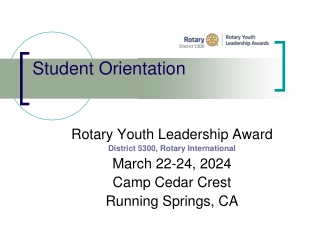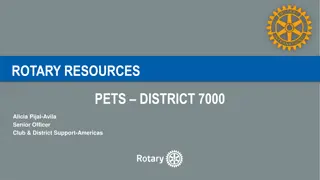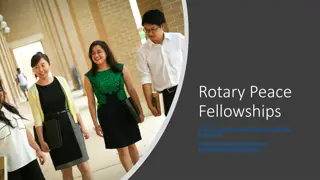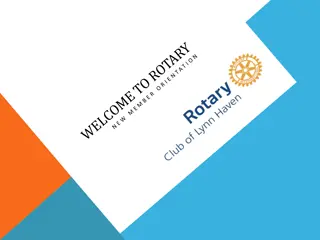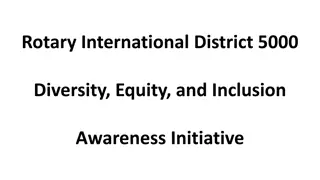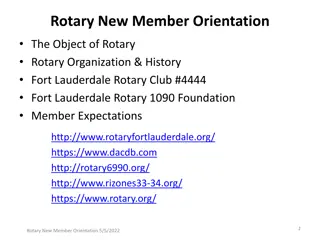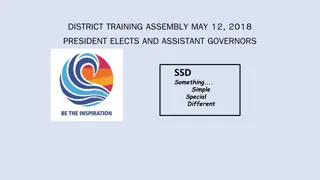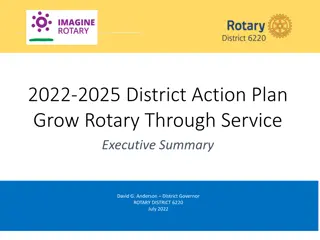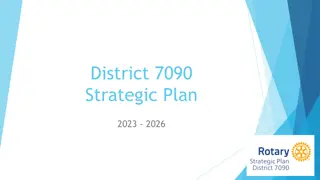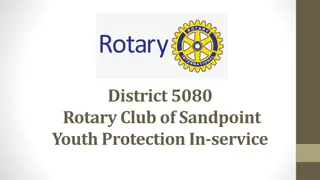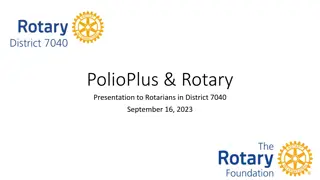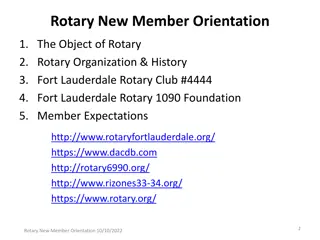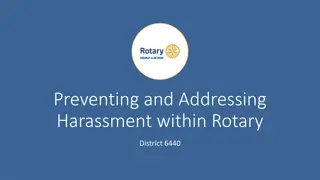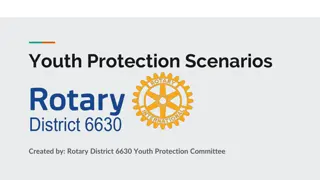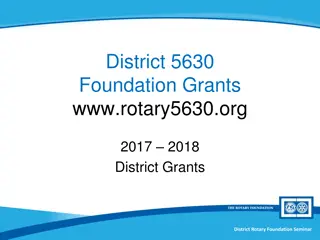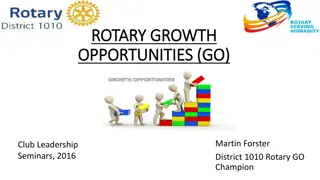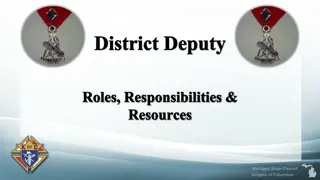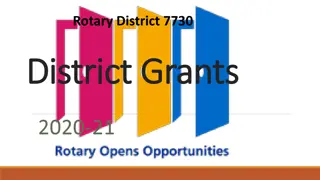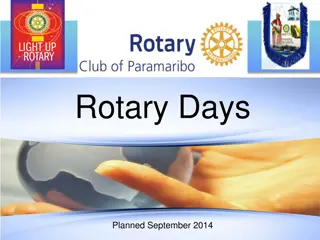Exploring the World of Rotary: District 6440 and Beyond
Rotary is a global network of neighbors, friends, leaders, and problem-solvers working together to create positive change locally and internationally. From fostering service ideals to promoting ethical standards and international understanding, Rotary has a rich history of impactful firsts and inspiring mottos. Explore the diverse facets of Rotary's mission and discover how this organization continues to make a difference in communities worldwide.
Download Presentation

Please find below an Image/Link to download the presentation.
The content on the website is provided AS IS for your information and personal use only. It may not be sold, licensed, or shared on other websites without obtaining consent from the author.If you encounter any issues during the download, it is possible that the publisher has removed the file from their server.
You are allowed to download the files provided on this website for personal or commercial use, subject to the condition that they are used lawfully. All files are the property of their respective owners.
The content on the website is provided AS IS for your information and personal use only. It may not be sold, licensed, or shared on other websites without obtaining consent from the author.
E N D
Presentation Transcript
The ABCs of Rotary DISTRICT 6440
What is Rotary? Rotary is a global network of 1.2 million neighbors, friends, leaders, and problem-solvers who come together to make positive, lasting change in communities at home and abroad. Rotary members look for opportunities to improve our communities today and invest in the next generation for tomorrow. We collaborate with community leaders who want to get to work on projects that have a real, lasting impact on people s live We connect passionate people with diverse perspectives to exchange ideas, forge lifelong friendships, and, above all, take action to change the world.
Object of Rotary: The Object of Rotary is to encourage and foster the ideal of service as a basis of worthy enterprise and in particular to encourage and foster: 1. The development of acquaintance as an opportunity for service 2. High ethical standards in business and professions; the recognition of the worthiness of all useful occupations; and the dignifying of each Rotarian s occupation as an opportunity to serve society. 3. The application of the idea of service in each Rotarian s personal, business, and community life. 4. The advancement of international understanding, goodwill, and peace through a world fellowship of business and professional persons united in the idea of service.
Rotary Mottoes: The first motto of Rotary International, He Profits Most Who Serves Best was approved at the second Rotary Convention, Portland, Oregon in 1911. In 1989 the Council on Legislation established Service Above Self as the principle motto of Rotary. Presidential Theme: Each year the incoming RI President will decide on a theme for their presidential year. In 2017/18 Pres. Ian Riseley s theme Making a Difference 2018/19 Pres Elect Barry Rassin s theme Be the Inspiration
Definition of Rotary: Rotary is an organization of business and professional persons united worldwide who provide humanitarian service, encourage high ethical standards in all Vocations, and help build goodwill and peace in the world. Rotary s Wheel Emblem: A wheel has been the symbol of Rotary since our earliest days. The wheel was said to illustrate civilization and movement . In 1922, it was decided that all Rotary clubs should adopt a single design as the exclusive emblem of Rotary International.
Rotary Firsts: The first Rotary club meeting was in Chicago on 23 February 1905. The first regular luncheon meeting were at the Oakland, California, club chartered in 1909. The first Rotary convention was in Chicago in August 1910. The first Rotary club outside of North America was organized in Dublin, Ireland in March 1911. The first Rotary club outside of the United States was organized in Winnipeg, Manitoba, Canada in November 1910. The first Rotary club in Asia was chartered in Manila, Philippines in June 1919.
The Four Way Test: Created by Rotarian Herbert J. Taylor in 1923. One of the most widely printed and quoted statements of business ethics in the world. The Four Way Test was adopted by Rotary in 1943. 1. Is it the TRUTH? 2. Is it FAIR to all concerned? 3. Will it build GOODWILL and BETTER FRIENDSHIPS? 4. Will it be BENEFICIAL to all concerned?
Avenues of Service: The five Avenues of Service support the Object of Rotary: Club Service involves all of the necessary activities Rotarians perform to make their club functions successfully. Vocational Service describes the opportunity each Rotarian has to represent the dignity and value of his or her vocation. Community Service pertains to those activities that Rotarians undertake to improve the quality in their community. International Service describes the many programs and activities that Rotarians undertake to advance international understanding, goodwill, and peace. New Generations Service recognizes the positive change implemented by youth and young adults through leadership development activities.
Rotarys Area of Focus: The areas of focus form an integral part of The Rotary Foundation s Future Vision Plan and the RI Strategic Plan. The most sustainable Rotary service tends to fall within one of six areas: Peace and conflict prevention/resolution Disease prevention and treatment Water and sanitation Maternal and child health Basic education and literacy Economic and community development.
Inclusion of Women in Rotary: Until 1989, the Constitution and Bylaws of RI stated that Rotary club membership was for males only. In 1978, the Rotary club of Duarte, CA invited 3 women to become members. The RI Board withdrew the charter of that club for violation of the RI Constitution. The 1989 Council on Legislation changed the RI Constitution with a vote to eliminate the male only provision from all of Rotary. Room 711 Rotary s Birthplace: The number 711 has a very special significance for Rotary. Room 711 of the old Unity Building was the birthplace of Rotary.
The Classification Principle: Virtually all membership in Rotary is based on a Classification Clubs should carefully consider the classification practice and broaden the interpretation of classifications where necessary to meet the current business, professional, and community service environment. Diversified Membership: A clubs membership should be reflective of the community it serves. Rotary recognizes the value of diversity with regard to professional and business classification, gender, age religion, and ethnicity. Sharing Rotary with New Members: Of all the obligation a person accepts when joining a Rotary club, the one which most Rotarians fail is Sharing Rotary Each club should have a well-balanced membership in which no one business or profession predominates.
Type of Membership: There are two types of membership: active and honorary. An Active member is one who has been elected to membership under a classification. Active members may hold office in their clubs and serve RI at the district and international levels. Honorary Rotary membership may be offered to people who have distinguished themselves by meritorious service in the furtherance of Rotary ideals.
District Governor: He or she is the single officer of Rotary International in the geographic area called a district. The district governor is a very experienced Rotarian who volunteers more than a year to leading the district; has a wealth of knowledge of current Rotary programs, purposes, policies and goals. Assistant Governors: This position was created in 1996 as a key element of the District Leadership Plan. These key district leaders help incoming club presidents plan for their year and advise clubs on strategies to achieve goals.
The International Assembly: Meets in January and prepares district governors-elect from around the world for the office they will assume 1 July. The District Assembly: Offers motivation, inspiration, Rotary information, and new ideas for club officers and committee chairs. The District Conference: Brings together all club members and their families to enjoy a celebration, fellowship and inspirational speakers. President-elect Training Seminar (PETS): Designed to prepare incoming club presidents for the office they will assume on 1 July.
Fall Training (ORS) One Rotary Summit (ORS) is all about the synergy among Membership, Public Image, and Humanitarian Service (The Rotary Foundation). ORS is about coming up with creative ways to achieve and sustain membership growth and retention, to increase Rotary Foundation giving and project engagement, and to gain enhanced public image in their communities. Winter Training Grants Management Seminar is mandatory that each club send at least 1 member in order to qualify to process grant applications. You will learn about the procedures and policies critical to know for District and Global Grant projects, particularly what s new for the coming year.
The Rotary Foundations Beginning: In 1917, RI President Arch Klumph to the delegates to the Atlanta convention that it seems eminently proper that we should accept endowments for the purpose of doing good in the world. The endowment s first contribution was $26.50 in 1917. after 6 years it had reached to $700. The Rotary Foundation was formally established at the 1928 Minneapolis convention. During the past 100 years, the Foundation has spent $3 billion on life-changing, sustainable projects. Why donate to the Rotary Foundation? The Rotary Foundation is a not-for-profit corporation funded solely by voluntary contributions from members and friends of Rotary who support its mission to advance world understanding, goodwill, and peace. Using Rotary Foundation grants, Rotary's 34,000 clubs across the globe develop and carry out sustainable humanitarian projects throughout the world. According to Charitable Navigator, The Rotary Foundation has been awarded its highest honor 100%
What your contribution does for you: With your help, we can make lives better in your community and around the world. Your donation makes a difference to those who need our help most. More than 90% of donations go directly to supporting our service projects around the world. Our partners make your donation go even further. For every $1 Rotary commits to polio eradication, the Bill & Melinda Gates Foundation has committed $2. How does The Rotary Foundation use donations? With donations like yours, we ve wiped out 99.9 percent of all polio cases. Your donation also trains future peacemakers, support clean water, and strengthens local economies.
Paul Harris Fellows: The most important step to promote voluntary giving to The Rotary Foundation occurred in 1957, when the idea of Paul Harris Fellow recognition was approved. The Paul Harris Fellow recognition acknowledges individuals who contribute, or who have contributions made in their name, of $1,000 to The Rotary Foundation of Rotary International. Paul Harris Society: The Paul Harris Society recognizes Rotary members and friends of The Rotary Foundation who elect to contribute $1,000 or more each year to the Annual Fund, Polio Plus Fund, or approved global grants.
Future Vision Plan: We just had The Rotary Foundation s 100 year anniversary in 2017, the Trustees set out to develop a plan to move the Foundation toward its second century of service. To simplify the grant-making process , the Future Vision Pan offers three types of grants: district grants, global grants, and packaged grants. Districts must become qualified in order to receive grant funding from The Rotary Foundation. Becoming qualified is simple agree to the club qualification MOU. and send at least one club member to a grant management seminar.


